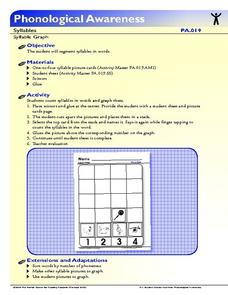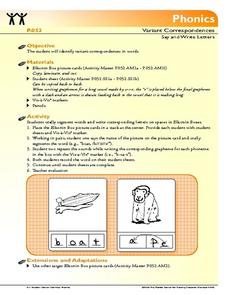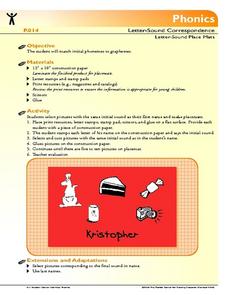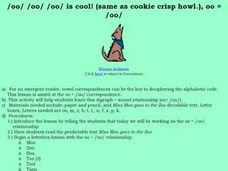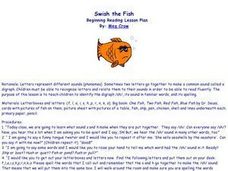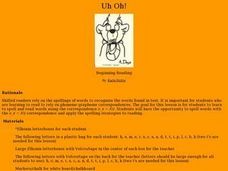Florida Center for Reading Research
Phonological Awareness: Syllables, Syllable Graph
Scholars make a pictograph based on the number of syllables in each picture card. They choose a card, say the name of the object on the card, break the word into syllables, count the syllables, then glue the picture onto the number chart...
Florida Center for Reading Research
Sound it-Bag it
Scholars sort picture cards based on the initial phoneme they hear as they say the name of each image. They pick a card, say its name, then place it in one of five bags based on how its initial phoneme matches the initial phoneme...
Florida Center for Reading Research
Phonics: Encoding and Decoding, Letter Cube Blending
Emergent readers use a letter cube to identify, blend, and make words. They roll each of the three-letter cubes, mark down the letters they rolled, then blend the letter sounds together to make a word. They record each word on a...
Florida Center for Reading Research
Phonics: Variant Correspondences, Say and Write Letters
Scholars sound out and write twelve different words. Using Elkonin boxes, pupils say the name of each picture, then write the letters that make each sound.
Florida Center for Reading Research
Phonological Awareness: Rhyme, Rhyme Memory Match
Young scholars play a memory-matching game to practice recognizing rhyming words and sounds. With picture cards, they flip over two cards and say the pictures' names. If the pair make a rhyming match, the learner keeps the cards. The...
Florida Center for Reading Research
Phonics: Letter-Sound Correspondence, Letter-Sound Pyramid
This fun game is a way to help your littlest learners build strong phonological awareness. Scholars equipped with letter triangles, a stack of picture cards, and counters choose a picture card, say the name of the image, and attempt to...
Florida Center for Reading Research
Phonics: Letter-Sound Correspondence, Photo Chart
Have fun with student photographs in this phonics activity! Learners sort their classmates' photos by initial sound on a large poster board with the alphabet written vertically down the left side. Also provided are various pictures...
Florida Center for Reading Research
Drop and Say
This neat idea gets kids to use phonics and puzzle-solving skills. Pairs take turns picking picture cards from a pile, say the name of the object on the card, drop a letter to turn that word into a new word, then look for the new word on...
Florida Center for Reading Research
Phonological Awareness: Onset and Rime, Guessing Game
An activity challenges scholars to show what they know about onset and rime. Learners choose from a stack of picture cards and give onset and rhyming clues to see if their partners can guess the word they are holding.
Florida Center for Reading Research
Phonics: Letter-Sound Correspondence, Letter-Sound Place Mats
Young scholars create personalized place mats as they learn about initial sounds. Using construction paper, they stamp their names using letter stamps. Scholars examine print resources and cut out pictures with the same initial sound as...
Florida Center for Reading Research
Fluency: Letter-Sound Correspondence, Make a Match
A memory activity engages young learners in letter-sound correspondence. Pairs take turns examining two sets of cards lying face down. They flip one image card and one letter card, then name the initial sound. If the sounds match, pupils...
Florida Center for Reading Research
Rhyme or No Rhyme
Scholars listen to a rhyming song, clap when they hear a rhyme, and shake their heads when they don't. They then draw a pair of objects that rhyme.
Houghton Mifflin Harcourt
Down on the Farm: English Language Development Lessons (Theme 8)
Down on the Farm is the theme of this series of ESL lessons designed to support reading, speaking, and listening skills. Over three weeks, your learners will have the opportunity to sing songs, play guessing games, create masks, role...
Curated OER
The Kite is Key
Students recognize the phoneme /k/. Through listening and matching activities, students discriminate the phoneme /k/ from other letters and phonemes. They associate the phoneme /k/ with its letter representation and identify the phoneme...
Curated OER
Cranking Cooky Cars
Students practice the strategy of phoneme awareness with special vocal gestures or sound with the correspondence /k/. They listen as the book, "ABC," by Dr. Seuss is read to them and then they work on a tongue twister and worksheets.
Curated OER
Quick, Quack, Quick Went The Duck
Students practice recognizing the phonemes and diagraphs in letters that blend together to form the "ck" sound. They interact with the book, "Quick, Quack, Quick!" by Marsha Arnold and the phrase, "Jack the duck found an icky sticky...
Curated OER
Cookie Crisp Howl
Students are introduced to the vowel pattern that produces the /oo/ sound in words. Through matching, listening, and spelling activities, students recognize the phoneme /oo/ and it's placement in words. They write a message using words...
Curated OER
Clifford Phonics Fun
Students develop phonemic awareness skills. They recognize consonant sound spellings and distinguish easily confused letter pairs. Students examine common short and long vowel sound spellings. They read stories containing high frequency...
Curated OER
The Big Pig
Students recognize the short vowel i in written and spoken language. Through matching activities, they discriminate the short vowel /i/ from other vowel sounds. Students associate the phoneme with its letter representation and identify...
Curated OER
Swish the Fish
Students study the /sh/ phoneme by making the sound, and reciting a tongue twister. Next, they make words that the teacher models using their Elkonin letterboxes. While using the big book version of Dr. Seuss', One Fish, Two Fish, Red...
Curated OER
I Scream You Scream We All Scream for Ice Cream!
Use letter boxes and example words to help kids distinguish between the sounds for short vowel e and long vowel e. They are introduced to the vowel patterns that comprise long vowel sounds, with a particular emphasis on /ea/. They...
Curated OER
Uh Oh!
Help your elementary learners distinguish between short and long vowel /o/ sounds. They are introduced to the vowel-consonant-e pattern that changes short vowel sounds into long vowel sounds. Then they practice reading and spelling words...
Curated OER
Shhh!
What sound do fish and ship have in common? Study the /sh/ sound with your young learners. They hear a common tongue twister, spell words in their letter boxes, and read The Rainbow Fish by Marcus Phister to hear the words in context.
Curated OER
Indians Are Coming!
Help your class increase their awareness of concepts related to reading and spelling. They identify the digraph /oa/ in spoken language and spelling. After a brief discussion, they read A Toad on the Road, listening for the target sound....


